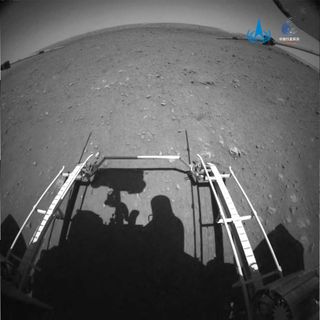China's Zhurong Mars rover rolls onto the Martian surface (photos)
China's first Mars rover is driving on the Red Planet.
China's first rover on Mars, the six-wheeled Zhurong, rolled onto the Red Planet's surface late Friday (May 21) to begin exploring its new home: the vast Martian plain of Utopia Planitia.
Zhurong, which landed on Mars a week earlier on May 14, drove on to the Martian surface from its landing platform at 10:40 p.m. EDT on Friday (10:40 a.m. Saturday, May 22 Beijing Time). It is expected to spend the next 90 days mapping the area, searching for signs of water ice, monitoring weather and studying the surface composition.
Photos from Zhurong released by the China National Space Administration show views from the rover's navigation cameras. In one image, the rover is still atop its lander and looking down at the twin ramps it took to roll onto the Martian surface. A second photo looks back at Zhurong's three-legged lander, which delivered the rover to the Martian surface last week.
Related: China's Tianwen-1 Mars mission in photos

The 530-lb. (240 kilograms) rover, which is named after an ancient fire god from Chinese mythology, arrived at Mars aboard China's Tianwen-1 spacecraft, which launched in July 2020 and is now orbiting the Red Planet.
Zhurong is a solar-powered rover designed to last at least 90 Martian days (called sols) on the surface of Mars. It is equipped with high-resolution cameras for photographing and mapping its Utopia Planita home. The rover also carries a subsurface radar to look inside the Martian surface, a multi-spectral camera and surface composition detector, a magnetic field detector and a weather monitor.
Related: The Mars rovers — A history
Get the Space.com Newsletter
Breaking space news, the latest updates on rocket launches, skywatching events and more!

China is only the second country after the United States to land a rover on Mars and Zhurong joins two other active rovers, NASA's Curiosity and Perseverance, now exploring different parts of the Red Planet.
The Tianwen-1 spacecraft, meanwhile, is expected to study Mars for at least a full Martian year, about 687 Earth days.
NASA has also landed three previous rovers to Mars, Sojourner in 1997 and the twin rovers Spirit and Opportunity in 2004, all of which have ended their missions. The European Space Agency will launch its own Mars rover, the Rosalind Franklin, to Mars in 2022 as part of its ExoMars mission.
Email Tariq Malik at tmalik@space.com or follow him on Twitter @tariqjmalik. Follow us on @Spacedotcom and Facebook and Instagram.
Join our Space Forums to keep talking space on the latest missions, night sky and more! And if you have a news tip, correction or comment, let us know at: community@space.com.

Tariq is the Editor-in-Chief of Space.com and joined the team in 2001, first as an intern and staff writer, and later as an editor. He covers human spaceflight, exploration and space science, as well as skywatching and entertainment. He became Space.com's Managing Editor in 2009 and Editor-in-Chief in 2019. Before joining Space.com, Tariq was a staff reporter for The Los Angeles Times covering education and city beats in La Habra, Fullerton and Huntington Beach. In October 2022, Tariq received the Harry Kolcum Award for excellence in space reporting from the National Space Club Florida Committee. He is also an Eagle Scout (yes, he has the Space Exploration merit badge) and went to Space Camp four times as a kid and a fifth time as an adult. He has journalism degrees from the University of Southern California and New York University. You can find Tariq at Space.com and as the co-host to the This Week In Space podcast with space historian Rod Pyle on the TWiT network. To see his latest project, you can follow Tariq on Twitter @tariqjmalik.
